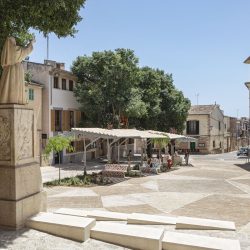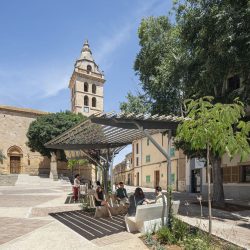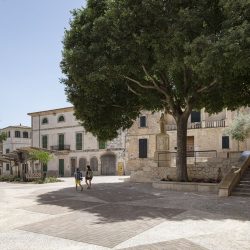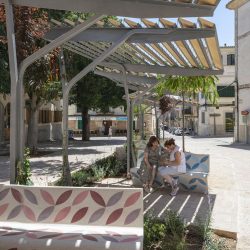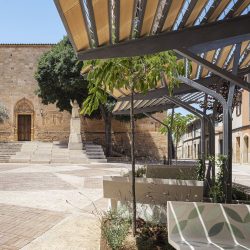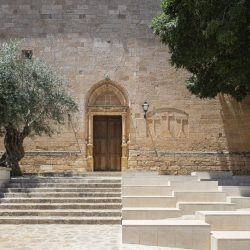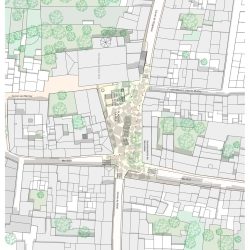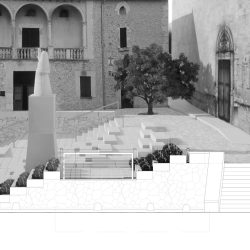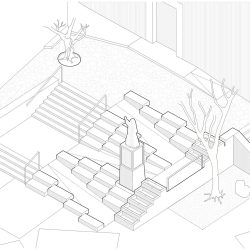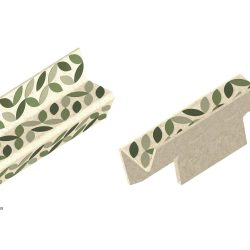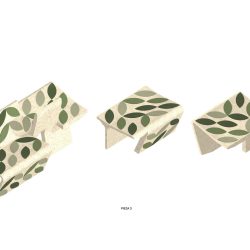
Moneo Brock Studio . photos: © Michael Moran/OTTO
The project is located in the main Plaza de la Vila in the little town of Sencelles, an important space for the citizens as it is bordered by the Parish Church, the Town Hall, the post office and the local bar “Café Cán Paris”. The bus to Palma stops in the plaza.
During the last decades the plaza had lost its use as an effective public space and was used principally as a parking lot. Issued by the mayor’s office, the competition brief called for the reevaluation of the vehicular circulation throughout the town in order to recover the plaza’s historic function as a meeting place for its citizens and as a venue for markets, dances, processions and other events. Once awarded the design, a process of citizen participation helped further define the needs and desires of the local residents.
One of the project’s main objectives was to provide universal access across the whole plaza and to each building fronting it. A new pedestrian ramp was designed to connect the two platforms that divided and separated the space, while at the same time increasing visual and physical connectivity across the square. The ramp is integrated into a field of fixed stone bleachers that offer seating for the events held in the plaza throughout the year.
The design is adapted to the specific climate of the place, with four outdoor rooms shaded by pergolas and surrounded by abundant vegetation that filters the light of the hot summer sun. These rooms house colorful benches and provide areas of repose and sensory enjoyment. All the building and plant materials used are of local origin and the employment of local crafts and construction techniques assured the square would have a decidedly Mallorcan character.
The new public space is now a large meeting area and a place of social integration. By eliminating the sidewalks, curbs and asphalt, the new continuous paving unifies and enlarges the square, erasing architectural barriers while maintaining a one-way vehicular passage delimited by bollards.
Orientation, sunlight, shading
The site is located within the town’s dense urban area. Buildings partially shade the square depending on the time of day and the season, while large trees offer additional protection from the sun. Even so, the interior of the square is often in full sun during the summer; hence our introduction of pergolas, additional shade trees and climbing plants to greatly magnify the areas protected from the hot summer sun.
The pergolas are composed of slats, whose orientation was studied to maximize shade during the hottest parts of the day. The slats are composed of locally-sourced ceramic extrusions which require virtually no maintenance and whose texture and color integrate well with the surrounding building fabric.
Water and Biophilic design
Ceramic pavers allow rainwater to filter through to the subsoil. This absorbed water helps reduce the surface temperatures of the square as well as the irrigation required for the new plantings. Surface water not absorbed is diverted first into the planters and lastly to drains. The absorption of rainwater and the abundant new vegetation generate a microclimate that helps lower the temperature of the square in summer.
Accessibility and Traffic Pacification
The project’s most fundamental improvement to the quality of the public space is in its pedestrian-friendliness. A new pedestrian ramp provides universal accessibility, connecting the lower levels of the square to the parish church of San Pere (1236 AD), while the new design eliminates all car parking from the square and greatly pacifies the traffic that must necessarily pass through it.
Materials
We sought coherence and simplicity in the use of materials with the idea that the space be well-integrated into the historical context. Materials were sourced locally and traditional construction systems were employed. The new plaza requires minimum maintenance.
EXPERIENTIAL QUALITIES
We believe in the power of quality design and dedicate our efforts to achieve beauty.
A series of open-air living rooms are introduced, shaded by pergolas, furnished with benches, and surrounded by a filter of vegetation. The informal arrangement of the pergolas adjusts to the irregularity of the square. This arrangement encourages casual encounters of people. These open-air rooms re-create the classic intergenerational Mediterranean plaza, where young children can play games and the elderly can rest, observe, and converse. It is a convivial place of exchange in the public realm.
The design allows for flexibility of use and for simultaneous activities, generating both quiet and private spaces that can combine with other dynamic areas full of activity. On a day-to-day basis it can be a place to play, meet or rest, while on Saturdays the market finds an organizational structure for the stalls within the arrangement of the pergolas. Its renovation has significantly improved traditional and one-time events such as festivals, concerts, dances or small performances; the design offers an increased capacity, better sight lines and no barriers. Overall, the cultural and experiential benefits are immense.
The vegetation and the pergolas enhance the experience, not only acting as a filter and providing shade and privacy but also adding color, smell, texture, and freshness to the whole.
We designed the benches to incorporate Majorcan hydraulic tiles, at once highly decorative and representative of the island. The benches aim to provide maximum comfort, their design has been carefully considered to be ergonomic. The benches were molded in fiberglass-reinforced terrazzo in a local workshop. The design contributes its particular character to the project without being disruptive to the environment.
INCLUSION AND ACCESIBILITY
By eliminating the sidewalks, curbs and asphalt, the new continuous paving unifies and enlarges the square, erasing the existing architectural barriers even as a unidirectional vehicular path shared with pedestrians and cyclists and delimited by bollards is maintained.
The proposal enlarges the staircase to the church and adds a ramp woven through a grandstand. The height difference between each ramp landing is 55cm, obviating the need for railings along its route. The result is a set of well-integrated elements: stairs, ramps, platforms and fixed bleachers.
Wi-Fi has been installed throughout the square so that the space returned to its citizens adapts to new social needs and attracts a younger population.
CITIZENS AND SOCIETY
The competition brief called for the plaza’s recovery as a venue for markets, dances and processions. Once awarded the design, a process of citizen participation was initiated to help further define the needs and desires of the local residents. There were two extended sessions held in the town, both well-announced and very well attended. The architects and representatives from the town administration answered questions from the attendees and heard their concerns. Specific geometries of the design were reviewed as well as material selection and the treatment of the existing materials, plants and artifacts. Specific issues that citizens brought to the meetings include:
• The inclination of the plaza floor was discussed vis-à-vis its appropriateness for large public dancing; the plaza slope was minimized.
• The exact position of the town’s monument, a statue of the Beata, was reviewed to assure that the placement of floral wreaths on festival days could coexist with the ramp and grandstand functions that surround the statue.
• The position of the pergolas was discussed to assure that the useful area for gatherings would be maximized.
• The conservation of trees and the re-use of stone material from the historic plaza was assured.
• The selection of new plants was reviewed by the public and their suggestions incorporated into the plaza design.
STAKEHOLDERS
We were regularly engaged with two principal stakeholders from the town: Joan Carles Verd, the mayor, and Jordi Llabrés, the town’s official chronicler, who was also employed by the church and so acted as interlocutor with that entity.
Joan Carles was a demanding client (always a positive force in an architectural project) in large part because he was very mindful of wishes of the townsfolk; he was sensitive to both their emotional attachments and their material needs. He knew what would be objectionable and what would be liked, and he demonstrated the foresight to see beyond the immediate complaints that he was receiving and anticipate the positive reception of the finished project. His faith in its positive outcome helped us weather the storm that was “tearing up” the central square in the town, disrupting traffic long-held habits of the residents.
Jordi was very helpful in providing us with historical material so that we could understand what lay beneath the existing material finishes in the square and to simply see how it had been configured through the various periods for which documentation was available. As interlocutor with the church, he also proved indispensable in securing approvals for the alterations that were made to its entry to make it universally accessible.
The regional government was also involved since our project affected the traffic patterns in the town and a stop on a regional bus route had to be relocated. The project included a master plan for the rerouting of vehicular traffic in and around the town which met with the approval of the regional government although this lay beyond the scope of the current project. The mayor did, however, independently secure additional parking outside the town center according to our suggestion.
The regional government also provided funds to achieve universal accessibility.
DISCIPLINES AND KNOWLEDGE FIELDS
A wide range of experts and leading members of the community were personally involved in both design and construction process. The involvement of town representatives was described above.
We can highlight the contribution of a talented group of landscape architects; Citerea who were decisive in specifying local plant species that would be well-integrated, attractive and easy to maintain for the project.
Also, it is important to note the collaboration of the firm Huguet, a generations-old family business and makers of hydraulic tiles and terrazzo on the island. They maintain traditional fabrication processes while infusing the business with contemporary designs in order to keep it relevant and viable in a competitive business environment. Their research and development department took on our bench design with gusto and together we developed an innovative fabrication process. The result is a novel and attractive product built to a very high standard.
Finally, Paviments Lloseta, a local earthenware and ceramics manufacturer, allowed us to experiment with a new color for the square pavers that would integrate best with the old town’s architecture.
RESULTS, OUTCOMES AND IMPACTS
There’s an elderly man that we have seen sitting under the pergolas every morning that we have visited the square since the project’s completion, bringing us joy and a sense of reassurance. Essentially, we have seen that the design has been embraced by the community from day one; since its opening, the rebuilt public space has become a focal point in social life for the town. Festivities, events and meetings are now being held in the plaza: dances and outdoor cinema on summer nights and religious ceremonies in spring.
It has established itself as a recognizable iconic and place for visitors as well, not in small part because it has become a favorite stop on bicycle touring routes in the region.
INNOVATION
Here we could highlight three aspects: integration, wellness, and memory.
In developing this project, we paid particular attention to its integration with the existing and historical townscape. We sought to avoid contrasts with the town’s existing architecture, a task with which we were helped by local artisans, as previously explained. The presence of motor vehicles has been restricted in order to return the space to pedestrians.
Special attention was given to the dialogue between architecture and landscape; together they create a space of enjoyment and wellness that engages the senses. Colors, textures and smells with a distinctly Mediterranean character mix in a space of conviviality and relaxation.
Our aim in this project was not to break with the past but to respect the collective memory associated with this place while still looking towards the future. We sought to recuperate and give meaning to those elements with historical and sentimental value for the citizens, and we believe this attentiveness resulted in the project’s rapid acceptance by the townsfolk.
To effectively intervene in those three aspects, we have developed a thorough and dedicated process of analysis and understanding of the town essence: a slow cooked architecture, so to speak. The maturity and care of this process contrasts with other mainstream interventions.
METHODOLOGY
We believe that design and architectures are tools for the enhancement and betterment of our society. Our objective is always to improve people’s lives. We consider public architecture the most relevant and important sub-discipline in our field, encouraging us to find deep roots for what we do in the specific social, political and urbanistic context in which we are working. In this case our approach was not an exception; we provided a platform and a climate conducive to dialogue between the different participating agents in order to completely assess the problems and so find their most appropriate solutions.
As explained before, we introduced the project to the community of Sencelles several times, enabling a free exchange of ideas. This resulted in the application of some new ideas that enriched the plaza. As an architecture firm, listening to what the future user has to say about the design and involving them in the process are vital tools necessary to assure the success of the project.
Learning from the local contractors and adapting to their way of building also helped us succeed in achieving higher material qualities in the project. Finally, direct access to artisans and local builders provided an excellent opportunity to keep learning about local building techniques.
In terms of methodology, we strongly believe that caring about local culture and recovering traditional building techniques should form part of an architect’s working philosophy. This idea, along with a deep analysis of particular conditions at the place where a project is sited, is an approach that can be easily transferred to other places and contexts with different traditional backgrounds.
In our case, merging with the town’s manscape, meeting with local builders, artists and artisans, experts …acted as a great advantage. Local people become essential contributors to this project’s success. One could say a careful approach is more than desirable in every urbanistic intervention.
With regard to ideas for specific public spaces we would emphasize the creation of shared meeting places, open and suitable for everyone. We consider these concepts easily transferred to any town. It is not uncommon to see how urban planning pays little attention to mobility, allowing it to devolve and become less inclusive. This is an important consideration given the aging of the European population.
As a clear example of the application of these two concepts we can show the benches designed in collaboration with the Majorcan company Huguet. These comfortable, versatile, and easy to set up benches also bring a colorful sight and an opportunity for encounters between generations.
GLOBAL CHALLENGES, LOCAL SOLUTIONS
This Project poses, from a local scale at the Mediterranean excellences, some answers to global challenges such as the protection of well-being along with a healthy lifestyle through the slow life.
Additionally, the main question this Project tried to solve was regaining a town’s core public space for the pedestrians.
_
Team:
Client: Ayuntamiento de Sencelles
MONEO BROCK: Jeff Brock, Belén Moneo, Francisco Blázquez
Architecture Team: Federico Pérez, Javier del Pozo
Specifications Consutant: Carme Aguiló
Contractor: Penyal Xapat, Llorenc Bestard
Structural Engineering: Calter Ingeniería S.L.
Colaborador de paisajismo: Citerea (Ana Luego)
Photograher: Michael Moran
Materials Used:
Benches: Huguet Mallorca
Vaults: Ladrillerias Mallorquinas
Concrete Pavement: Paviments Lloseta
Locksmith: Ferreria Llorenç Simonet
Luminaires: LEDS C4
Nursery: Proyectos Paisajisticos de Baleares, S.L.

